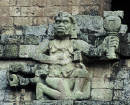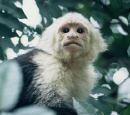|
![]()
The kings of Copán in northern Honduras make the House of Windsor seem very boring and commonplace – what exotic names they have: King Waterlily Jaguar, Moon Jaguar and Smoke Imix (Jaguar), the wise and powerful king who built Copán into a military stronghold around 690 AD.
Smoke Shell, the 15th king, had commissioned Copán’s most famous edifice, the Hierographic Stairway which climbs up a massive pyramid. The final touches to this amazing Mayan city were done by Smoke Shell’s successor, Yax Pac (Rising Sun), who reigned from 763 to 820 AD when the population peaked at 20,000. After the death of Yax Pac the city soon declined into oblivion; by 1200 AD the city was deserted and reclaimed by the jungle.
It was not until 1841 that an archeologist, John Stephens, brought the ruins of Copán to world attention. Excavation and restoration of the site began and continues to this day.
Robert Louis Stevenson said he travelled not to go anywhere but just to go. The planning of a trip and adventures along the way can be just as enjoyable as the destination. So too with Copán – it is not easy to get to but the effort of doing so is as rewarding as the destination.
I start my day’s journey from Punta Gorda in Belize, crossing the estuary by speedboat to Puerto Barrio, Guatemala, then go by second class bus to the town of Chiquimula, which is a convenient stopover point 58 kms from the Honduras border.
|
![]()
Next morning I take the Vilma bus to El Florida at the border post. A few Europeans are crammed in among the sardine-packed Indian folk. The bumpy dirt road winds through the mountains and along the river flats cultivated with tobacco and corn.
At the border post I change Guatemalan quetzals for Honduras lempira and I am thankful to have the familiarity of some US dollars in reserve.
The Honduras side has a few adobe shacks and chickens scratching on the dirt road that disappears up the jungle-clad hill. It is 12 kms to the town of Copán Ruinas located close by the ancient Mayan city. No bus is in sight – only a Toyota pickup owned by a friendly Honduran gentleman.
The eight Europeans who had traversed the border post congregate to compare notes.
“It should only cost us $3 to get to Copán,” informed an American couple. “The guy with the pick-up wants $5 a head.”
|
![]()
The two Germans, a Swiss, Italian, Argentinian and myself discuss this unexpected hike in transport fees. Half an hour later it is apparent that bargaining is futile as there is no alternative. $5 it is and we all pile into the ute.
We sit on Coke Cola crates squeezed in with several Indians, children and two dogs – off we bump along the potholed road through the jungle. At each adobe shack we stop to deliver goods and exchange passengers. We reach the plaza of the sleepy town of Copán Ruinas with a record 14 passengers and gear crammed in the back of the ute.
All the Europeans are dropped off at Hotel Yax Pac, two blocks from the plaza. My shared double room is spartan, but good value at $9. An over-friendly Macaw parrot supervises our arrival before being put to bed in a cage.
Martin, my new Argentine friend is helpful with the Spanish. We stroll the cobblestone streets always accompanied by a small boy who insists on being our guide. “No, we don’t want to hire a horse. Not today, anyway.” There are more horses than cars in town. He directs us to a good beer garden and restaurant, so we give him a few coins.
Why is Copán so special? It is the most southern of the ancient Mayan cities. The jungle setting is superb. Massive trees still grow on the sides of temple pyramids, on walls and in the plazas. It is easy to imagine the site 100 years ago completely smothered by dense vegetation. Monkeys scuffle about and gaudy Macaw parrots watch the tourist unfazed.
An enormous amount of forest clearing has been done to achieve the present immaculate lawn setting of the major structures. Excavation continues unabated. Facades are cleaned of vegetation and protected from weathering by awnings. Tunnels are being dug into several structures to search out royal tombs and so piece together the history in more detail.
|
![]()
Recently a treasure trove of pottery and jade ornaments was found in the tomb of King Yax Kuk Mo, dated 400 AD.
The lawn of the Great Plaza is dotted with intricately carved 4 metre high stone statues, or stelae, which are stylised representations of kings who ruled in the period 610 to 740 AD. What a pity Picasso never saw King 18-Rabbit in all his bizarre formulations!
|
![]()
Across the Ball Court is the famous Hieroglyphic Stairway up a major temple-pyramid; the 63 steps are ornamented by thousands of intricate carvings, or glyphs, depicting the history of Copán. It is now protected from the elements by an extensive canvas awning which somewhat detracts from the aesthetics.
Overlooking the Great Plaza is the Temple of the Inscriptions where images of all the 16 kings of Copán are carved in bold relief, including Yax Pac its creator and final royal.
What the tourist gets to see are the Principal Group of excavated structures within a 500 metre square area, securely fenced in. Beyond is 24 square kms of jungle with 3500 mounds containing ruins awaiting excavation and study. A museum block adjacent to the Visitors’ Centre explains all.
|
![]()
What amazes me is that over a period of a few hundred years such a magnificent city could be created and flourish briefly, only to vanish swiftly beneath the jungle, like some exotic flower of human endeavour.
Further north on Mexico’s Yucatán Peninsula are Mayan cities that survived until the Spanish Conquest in the 16th century. The Spaniards did not know of Copán as it remained hidden in the jungle, safe from the ravages of colonists and adventurers.
Copán is the southernmost of the ancient cities of the vast Mayan civilization that flourished in The Classic Period of 300 to 900 AD. Today, national boundaries put it in northern Honduras, some 12 kms from the border with Guatemala.
Besides its jungle setting and abundance of stelae, its attractiveness for the traveller is enhanced by being off the beaten tourist track and the difficulty in …
Getting There
The ruins are on the outskirts of the sleepy colonial town of Copán Ruinas, population ca 24,000, quaint, with cobblestone streets, more horses than cars, and white adobe buildings. There is no local airport.
From Guatemala
Least hassle way is through a tour operator e.g., Monarcas Travel who run a minibus service between Antigua, Guatemala, and Copán, cost US$29 one way. They also do a shuttle service between Guatemala City airport, Antigua and Panajachel, door to door, with online booking.
If you are in a hurry, Jungle Flying does charter flights to a new airstrip close to the Guatemala border, only 20 minutes drive from Copán. They also fly into Tikal and Palenque; enquire at Guatemala City airport, or fax 011 502 331 4995.
The DIY traveller can head by bus for a welcome stopover at Chiquimula, 58 kms from the border, in anticipation of a following day’s adventure using local buses, etc to the border post at El Florida, and onto Copán by whatever transport presents itself, taking all day, and costing only a few dollars!
From Honduras
Regular buses from the city of San Pedro Sula, population ca 400,000 (168 kms, 4 to 5 hours to Copán). There is a domestic and international airport with direct flights to/from the US.
|
Accommodation
Copán Ruinas
Upmarket tourist hotels include Posada Real (US$100 double), Marina Copán (US$98 double) and Camino Maya (US$65 double).
Good value is the bed/breakfast inn “La Casa de Café” (US$38/double) and many budget hotels, Hotel Yax Pac (Check Lonely Planet), also a backpacker lodge Iguana Azul (US$5 dorm, $11 pte room).
Chiquimula
Population ca 35,000, 200 km by road from Guatemala City. Many budget hotels to choose from; Victoria Hotel 2 blocks south of the bus station is bearable at US$10/double.
San Pedro Sula
Budget travellers head for the Hotel San Pedro on 3a Calle, 2 blocks east of the main Plaza. (US$15 double upwards), but frequent the Café Skandia in the Gran Hotel Sula, north side of Plaza (ca US$100 double) to eat in air-conditioned comfort. Bus details, etc check Lonely Planet Honduras Guide.
Useful Web Sites
Museum of Copán;
Pictures of Copán;
Fronteras to Copán;
History;
Copan Update;
Travel links;
Guatemala Links;
Weather Report for San Pedro;
Currency Exchange.
The Author

You can visit Allano’s web site by clicking here.






